
| My
trip to Mongolia in August 2004 was a short one but still unforgettable.
Participating in the Conference on “Present State
and Perspectives of Nomadism in a Globalizing World” took most of my
time but whatever time I had left I tried to use it exploring Mongolian
past and thinking about its future. This unusual country is mostly known
for Genghis Khan (Chenghiz Khan), feared by the most of the “civilized”
world in the 13th century, and admired indiscriminately by his Mongolian
contemporaries and all future generations of the proud Mongols. His empire
of the steppes, based on nomadic tribal associations, stretched from Hungary
to Vietnam. His grandson, Kublai Khan, “finished” Genghis Khan’s dream
of conquering whole China. He proclaimed himself not only the Great Khan
of the vast steppes and conquered territories in almost all of Asia and
European Russia (including “short trips” as far as Central Europe and Southeast
Asia) but also carried the title of a Chinese Emperor by establishing the
Yuan Dynasty (1279-1368). .... |
|
| The
greatness of the 13th and 14th century Mongolian steppe empire is known
to the Westerners thanks to the writings of Marco Polo, whether he actually
visited all described places in person or not (still a subject of many
scholarly discussions). |
 |
|
..
 |
 ... ... |
The
history of Mongolia after 1368 has not produced personalities of the Genghis
Khan and Kublai Khan’s caliber (a very few leaders in the history of the
world can match their achievements and legend), but many brave nomads fought
for their freedom and autonomy against China and/or Russia, the powers
whose political interests have always been at odds with each other. Interested
only in controlling Mongolia as a political and military buffer, neither
one of them cared in investing in it and developing its numerous natural
resources. |
...
| Thus,
by default, Mongolia has entered the 21st century almost unchanged since
the time of its greatest leader. If one was to erase Ulaan Baatar (Ulaanbaatar)
from the map, the rest of Mongolia looks probably less “civilized” that
under Genghis Khan. He would have probably feel disappointed seeing its
empire reduced not only in its size but also in number of nomadic settlements
forgotten by time and living in poverty as compared to the riches of the
world he showered them with in the past. However, the true beauty of his
empire has survived in its land and its people, making Mongolia one of
the most interesting and unusual countries to visit today. |
 ... ... |
 |
Enjoy
browsing through this section of my website but, remember, I saw only a
small part of Mongolia - for more I will be back, hopefully, in the future.
E-mail me at Mruczek@AOL.com if you
have any comments.

|

EWA’S
FUNNY STORY: LET’S SPEAK MONGOLIAN!
Not
many people in modern Mongolia speak English or any other Western languages
although many, especially younger generation, are eager to learn them as
soon as possible. One would think that since Russian education was compulsory
in the communist Mongolia, the number of Russian speaking Mongolians would
be relatively high. However, like many of their counterparts in the communist
countries of the Soviet “Empire,” the Mongolians did everything possible
and impossible to “dislearn” this language faster than learning it. However,
I was not afraid of major language problems in Mongolia: after all I speak
fluent Russian and know Turkic languages, which share a common ancestor
with the Mongolian language. How wrong was I?
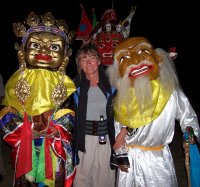 |
 ... ... |
Upon
arriving to Ulaan Baatar I decided to give myself a haircut after a month
of “mistreating” my hair under the scorching sun of Iran (see Iran)
and its obligatory shawls. For that I needed scissors. Staying in one of
the best hotels properly called Ulaan Baatar (unfortunately, still of the
Soviet era so its comfort and attractions are quite limited but not its
price), I called reception with my request in English. “No problem…Now,
it’s coming” a young voice of a male-manager informed me. After one hour
of waiting for a tool to be used in order to beautify my image I called
in Russian. “Net problema…” a young lady answered. Another hour passed
so I tried my Turkish. This time somebody just hung up on me. |
Since
desperate times call for desperate measures I had no choice but to use
my Mongolian. I found a Mongolian dictionary, which promptly provided me
with the word for “scissors” nicely written in the Cyrillic alphabet, that
has no mystery to me. “Khaich” seemed to be a simple enough word for me
to pronounce so once again I called the reception. The most educated of
the managers answered the phone exercising his knowledge of languages (“What?;”
“Chto?;” “Ne?;” “Quoi?”) after my each attempt to correctly pronounce “the
simple word.” I gave up! After a few hours of trying to get scissors
without actually going downstairs, I had enough. I dragged my tired body
down four flights of stairs to face my multilingual nemesis ready for me
in proper order of languages used for our miscommunication.
| The
English-speaking manager held the English-Mongolian dictionary; the Russian
educated girl was looking for one; and Mr. “What? Chto? Ne? Quoi?” was
smiling at me with a pity. The would-be speaking Turkish person was probably
hiding under the counter “ashamed” of hanging up on me. Being already humiliated
I pulled out my dictionary and screamed again “khaich!” They all grabbed
it and in unison yelled “kch!” (???) Well, I still don’t know how to pronounce
“scissors” in Mongolian but was able to cut my hair and learned a valuable
lesson for the future: Nothing sounds in Mongolian the way how it looks
in writing! |
 .. .. |
 |
Ewa’s
disclosure: If you wonder why I did not ask for scissors in person let
me tell you that after flying from Tehran through Moscow (almost 12 hours
of waiting at one of the worst international airports ever) to Ulaan Baatar,
I was too tired to leave my bed. Then, after the third attempt, it became
a matter of pride. So, at the end, I lost both: my pride and my sleep!

Map
of Mongolia
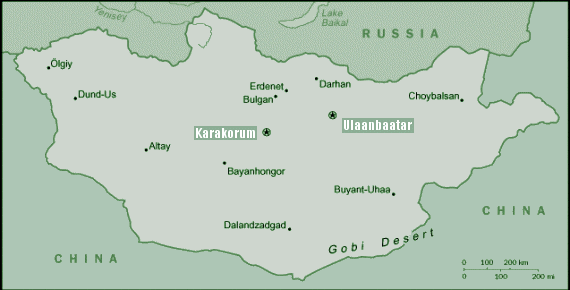
ULAAN
BAATAR
There
are two things that I always associate with communism: lack of creativity
in architecture (same, old same drab buildings with no visible attempts
to make them even slightly aesthetically pleasing) and lack of toilet paper
(unless one counts grayish/brownish thick blotting-paper on a roll as such).
While Ulaan Baatar is trying to overcome these shortcomings of the communist
system, it will take a long time to erase their memories. This is quite
unfortunate because this capital of Mongolia seems to be the only city
in the whole country, which can be given this term without any hesitation.

Since
1992, after the fall of the Soviet “empire,” Mongolia entered on its route
to industrialization and modernization focusing mostly on its capital.
Gradually, but too slowly for young people, its communistic past is being
replaced with technological wonders of the 21st century. Japanese SUVs
and Korean buses are becoming normality in the city where less than one-hundred
years ago horses, wagons, and camel caravans were roaming through the dirt
“roads,” passing hundreds of Buddhist temples, most of them destroyed by
the Soviet “inspired” government.
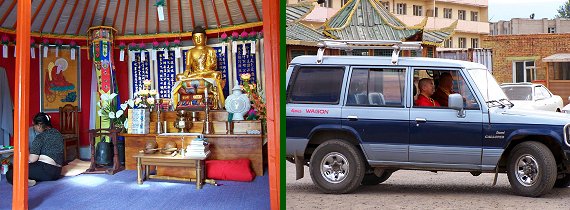
As
usual, modernization touched first the young generation of Genghis Khan’s
descendants proudly displaying their Western clothes, chatting on cell-phones
while waiting in Internet cafés for their turn in front of a computer.
They mingle with others still wearing traditional Mongolian attires and
with many monks who are glad to be able to practice their religion freely,
sometimes in official temples, at other times at small gers (see below)
set up in the middle of concrete apartment buildings.
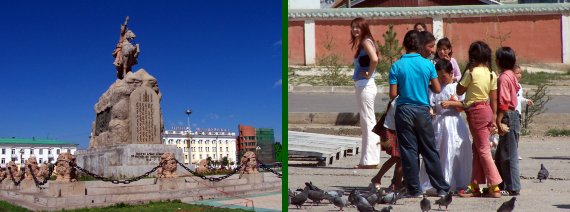
Ulaan
Baatar is the first permanent capital of Mongolia established in 1778.
Before that time, the capital known as Urga (a term derived from a “temple
ger”) was a mobile one moving almost continuously along the river valleys
of Orkhon, Selenge and Tuul. This was truly “The City of Felt” with thousands
of gers and temples referred to as the Great Camp under Bogd Khan. The
first permanent architecture, brick and stone temples, was constructed
in the first part of the 19th century and the name was changed to Nuslel
Khuree (Capital Monastery) in 1911. Thirteen years later, the city was
renamed once again, this time in honor of its revolutionary leader, Sukhbaatar,
as the Red Hero, Ulaan Baatar. The main square carrying his name is the
focal point of the modern city with his statue towering in its center.
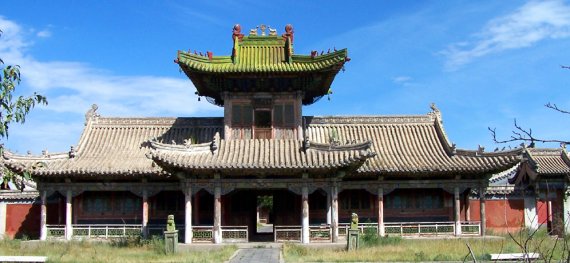
Less
than 50 years ago only ca. 50 thousand people inhabited this Mongolian
capital. Today Ulaan Baatar is home to at least a million people although
many Mongolians and foreigners believe that this number is much higher,
around 2 millions. This means that overwhelming majority of the Mongolian
population (ca. 2.7 million) is living in the only “true city” of Mongolia,
changing its suburbs into “The City of Felt” once again.
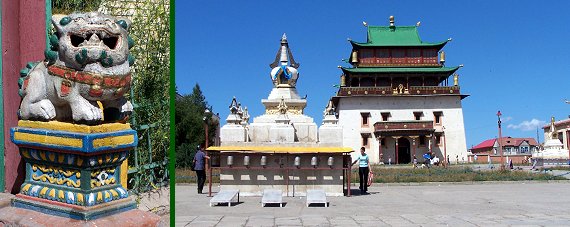
Many
herders moved with their families into makeshift ger-compounds where they
reside without basic city-accommodations as water, sewage system, electricity,
etc. However, they all hope for the better future for their children believing
that the life on the vast steppes of Mongolia is the story of the past
without any opportunities to be integrated into a new civilization in progress.
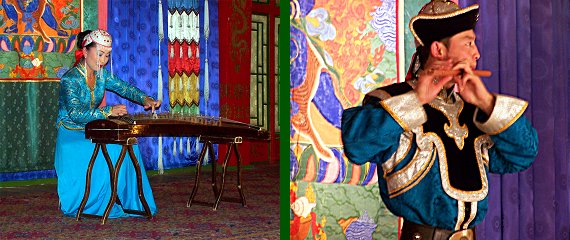
Although
Ulaan Baatar is known as the “coldest capital of the world,” its people
and its many attractions make one feels rather warm even in the winter
which one must avoid at all cost since temperatures in Mongolia can be
as low as -58C!
MUSEUMS
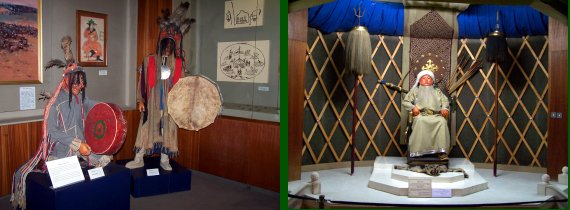
There
are many of them in Ulaan Baatar with most visitors overcrowding the Museum
of Natural History where an extraordinary amount of dinosaurs can be seen.
However, my most favorite museum is of the Mongolian History - simply exquisite.
The first floor is dedicated to the early past of Mongolia representing
an excellent collection of deer stones, gold and silver artifacts, stelas,
statues, etc. of the early Turkic period. This is one of the kind collections
where I could have spent hours. The second floor is about different ethnic
groups presenting their colorful costumes, jewelry, hats and domestic.
The third floor is the pride of Mongolia - the history of the Mongol horde
with Genghis Khan in its center, sitting on his throne in a great ger.
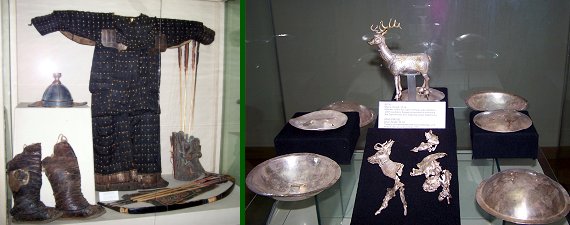
Numerous
weapons, clothes, inscriptions, documents, domestic implements, a traditional
furnished ger as well as some Buddhist artifacts are exhibited tastefully.
You want to skip the Soviet-era gallery unless you did not have enough
of dull buildings, statues, etc. spread all over the city.
MONASTERIES
Remembering
my experience from visiting Tibet (see China),
I made sure to stay away from any attempts by Buddhist monks to bring me
happiness or to cure any invisible illnesses lurking somewhere in my body.
Thus, I was only a spectator when in simple gers set up in different parts
of Ulaan Baatar, various monks were more than eager to fulfill my great
desire for happiness with ancient treatments. Acupuncture, acupressure,
herbal treatment as well as bone implements have been used to heal variety
of diseases including exorcism of evil spirits. In the Museum of Mongolian
History one can see the Ganlin Horn made from human thighbones that is
claimed to be very effective against all devil.
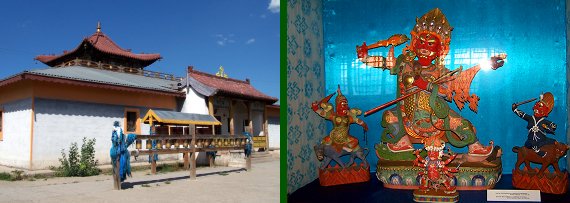
Although
I found small Buddhist gers of Ulaan Baatar very interesting and cozy,
I had to see other temples in the area, especially three famous ones whose
true long names are not pronounceable for non-Mongols: Gandan Monastery
(the only one open during the Soviet era), the Bogd Khan’s Green (Winter)
Palace Museum, and the Choijin Lama Temple/Museum. The first one is easy
to spot because of its 23 m statue of Buddha which is fit into a few storey
temple. It is the place of the Mongolian Buddhist University and includes
additional temple buildings erected at the end of the 19th century and
the beginning of the 20th. The Winter Palace of Bogd Khan is quite attractive
because it was the seat of the Eight Living Buddha who was also the last
king (1869-1924) living there for 20 years.
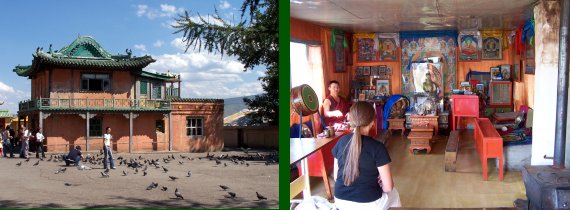
As
the story says, Bogd Khan (again, the real name is way too long and with
too many consonants) liked to expose his powers by hooking up “a car battery
to a long metal cord, hung it over the Winter Palace walls.” When any of
his followers touched the rope he experienced an electric shock reminding
him that the Living Buddha’s powers are beyond his comprehension. So was
his legendary drinking (one of the favorite activities of nomadic heroes
of the steppes). However, these are only few of his exploits - others are
too raunchy to be described here. The Choijin Lama Temple is more about
spiritualism and religion than about exhibit of wealth so visible in the
Bogd Khan’s palace where gold boots and a ger lined with snow leopards’
skin are main attractions.
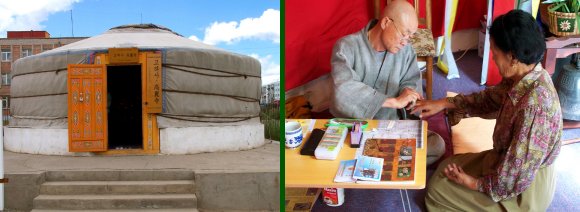
For
some strange reasons I found Mongolian monasteries more interesting than
the ones I saw in China. I guess, their stories seem to be more entertaining
and less holy than those of the main stream Buddhism.

STEPPE
Leaving
Ulaan Baatar means leaving the civilization, as we know it. There are no
roads, mostly dirt tracks (if you are lucky), and none of cell-phones is
working. So always be prepared for unexpected, like spending a night in
a friendly ger (if you find one, ger, not friendliness) because your car
breaks down and there is no-one to fix it or no parts are available within
400 km.

However,
this little inconvenience is always compensated by unbelievable view whether
of mountain ranges, steppes or deserts. Mongolia is one of a very few countries
in the world where time stands still allowing the traveler to admire her
diversified landscape, unspoiled habitat with many rare species of flora
and fauna. Each trip outside of Ulaan Baatar is a great adventure since
each day brings another discovery of this beautiful land. I regret that
due to the limited time I was only able to experience the vast steppes
of Mongolia with a brief glance at the Little Gobi with its quiet dunes.
But, what I saw I fell in love with … over and over again.

The
life of Mongolian nomads has never differed much from its Turkic nomadic
relatives (see Kazakhstan,
Kyrgyzstan,
and Uzbekistan). It has been
a mobile life, always in search of better pastures or better opportunities…
always in unison with nature whose destructive powers they respect and
whose beauty they admire…always thankful for each day and each meal. Guided
by the sun and sparkling stars they move through streams, seemingly endless
sea of wild grass, looking for familiar hills and stopping for a short
moment of prayer or admiration in front of deer stones or balbals (stone
sculptures known in Russian as kamyenniye baby).
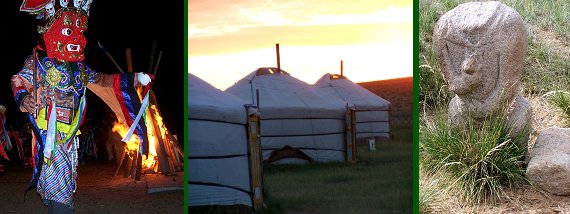
Some
of them may represent their heroes, others shamans and shamankas, dead
ancestors or leaders of different tribes. We may never know their exact
meaning because most of them were either destroyed or displaced under the
Soviet rule.

The
nomads share their long trips with their herds and most beloved of all
animals, their horses. While horses seem to be first domesticated by Indo-European
nomads, the Mongols and the Turks built the most interdependent and loving
relationship with them. Without horses there would not be nomads galloping
through the steppes. These heavenly animals made conquest of China, Central
Asia, Europe, and the Middle East possible. The nomads became one with
their horses whom their cherish as much as their human families. They are
born in the saddle whether they have one or not. They use them for battles,
hunting and transportation, for hides, milk and meat. In the terrible condition
of zud (“lack of grazing”) when a thaw is followed by freeze, horses are
believed to be the only chance to save herds since they can find patches
of grass not encased in ice and lead other animals to them. As the last
resort a hungry nomad would slit a side of his horse and drink his blood
to sustain him or her for yet another day.
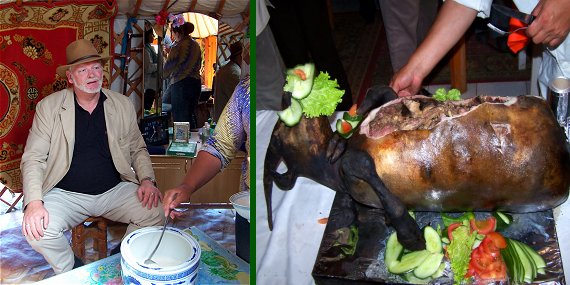
Koumiss,
horse’s milk, is the drink of the steppe whether fresh, mixed with fat,
or fermented to the point that one sip can make a visitor staggering as
a “drunken” panda (see
China). It
tastes somewhat better than camel’s milk (see Syria and Jordan) and becomes
your drink of choice after having yak’s “ambrosia” (see China).
Be prepared, because Mongolian hospitality is legendary - you don’t stand
a chance to refuse koumiss or any other traditional foods. Be grateful,
because no longer Mongolian nomads offer their women as a part of their
hospitality customs which called for providing a lonely traveler with four
things necessary for survival: shelter, food, drinks and sex!

The
most famous of Mongolian horses is takhi, also known as the Przewalski’s
horse (named after Polish explorer who is credited, unjustly, with its
“discovery”). This is the only wild horse (even mustangs are not pure “wild”),
which survived its near extinction in 1960s and once again is roaming through
its natural habitat of the Khustai National Park (Khustai Nuruu), not far
way from Ulaan Baatar (ca. 100 km), and at Takhiin Talin in southern Gobi.
There are around 160 of them after being reintroduced, thanks to international
efforts, to Mongolia between 1992 and 2000. They seem to be very shy so
my trip to the Khustai Park resulted only in seeing their pictures and
a movie but I felt good that this cousin of now extinct Polish tarpan is
still alive and well.
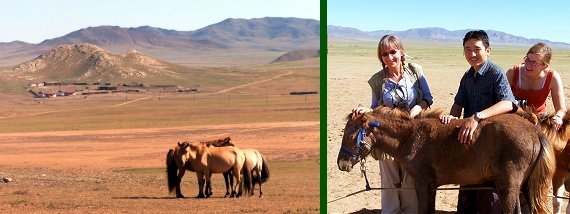
However,
I had plenty of opportunities to “play” with regular Mongolian horses.
They are small but don’t let their looks to deceive you. They can also
be very mean - after all they are still wild horses, pure or not pure.
Their size seems to be perfect for the Mongols who are, at average, rather
short. Young Mongolian girls are so tiny that I felt like a giant around
them. What do I mean? My American size 4-6 became 4XL on my Mongolian clothes!
Not good for any ego…

Another
symbol of the Central Asian steppe is a ger known in other Central Asian
Turkic countries as a yurt (yurta in Russian). This large, round, felt
tent has its early origin with the Indo-European nomads of Eurasia. Due
to its lightness, durability, flexibility and comfort all nomadic people
of the region adapted it as home. It is perfect for the nomadic lifestyle
since it can be carried easily on a wagon pulled by oxen (big gers of great
khans) or other animals, on a camel back, or on horses and on yaks (today,
trucks are used more often). It can be assembled within a short period
of time, from one hour to four, depending on its size and number of people
involved. It provides warmth during harsh winters and coolness during hot
summers since the number of felt layers can be adjusted.
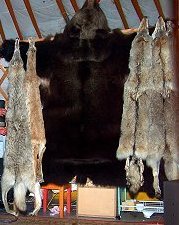 |
 ... ... |
The
cost of this prefabricated nomadic house is minimal: willow wood is used
for its collapsible wooden frame while felt is easily made from sheep’s
wool. Unless the ger is set up for a longer time when a wooden floor is
needed, these felt tents are placed directly on the ground which then is
covered with carpets and rugs. In Mongolia, the door always faces south
and is made either of felt or of wood. The small opening in the “roof”
of the ger is called a toon allowing smoke to exit and fresh air to enter.
It also works like a sun clock “telling” time when animals need to be milked,
etc. The average ger weights 250 kg without furniture, which traditionally
includes stove, low table and stools, beds, chests, cupboards. Some furniture
is placed inside the ger before it is erected because it would not fit
through the door. Some families have an extra ger to be used as storage
only. |
.
| The
spatial organization of the ger’s inside reflects Mongolian customs and
beliefs. The most important part is the back of the tent (khoimor), which
is reserved for the most honored guests, a family altar often decorated
with images of Buddha and family photographs. The right side (east) is
designed for women and here one can find cooking paraphernalia, water buckets,
etc. While women’s site is dedicated to the sun deity, the left side (west),
for men, is under protection of the sky god. |
 ... ... |
 |
These
two have been traditionally the most important deities of the Eurasian
steppe regardless of ethnicity of nomads and are still worshipped in spite
of Buddhism being the main religion of Mongolia since the 16th century.
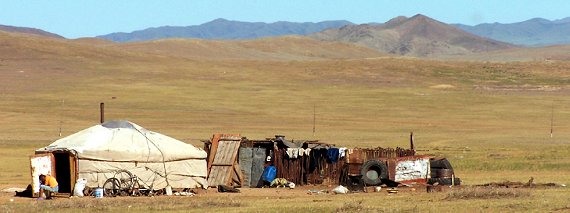
There
are many special customs associated with visiting a ger which one should
learn before exploring Mongolian hospitality. For example, never knock
on the ger’s door. It is considered not only impolite but you may not even
have a chance to do so if you don’t scream from the distance “Nokhoi khor!”
(“Hold the dog!”). Due to my language problems as described above, I just
yelled something similar as loud as I could to make sure that a vicious
monster is contained. Never refuse any food nor a drink but also don’t
finish your food. An empty plate/bowl indicates that the guest is still
hungry so the hosts will be refilling it as long as you eat. For more do’s
and don’ts check your guide before you offend anyone (just to be on a safe
side, remember not to use your left hand and never turn your back to an
older person, an altar, and any other religious objects). Always enjoy
your visit but remember not to abuse your host’s hospitality and leave
before two hours are over.
KHAR
KHORIN (KARAKORUM)
Located
in the Orkhon Valley, along the most important east-west routes across
Mongolia, the pastures of this region have been a focus of habitation and
important political and economic activity already in the 6th century (see
below). Khar Khorin, a great capital of the Mongol empire, has always been
associated with the name of Genghis Khan although he only selected this
place for a new capital after moving it from the Onon Valley in Khentii.

At
his time it could have been a small settlement but his third son and his
successor, Ogodei Khan, turned it into a legend by changing it into a flourishing
city. Unfortunately, its glory lasted only for 40 years, when Genghiz Khan’s
grandson, Kublai Khan, moved the Mongol capital to Beijing in 1264. The
city was erased from the ground in1388 by a Ming army leaving little to
admire today. Only a few sculpted bases in the form of turtles for inscribed
memorial stelas (now missing) remain collected from their original places
where they marked boundaries of the city in the past. Bricks and stones
left after the city’s demise by the end of the 14th century were re-used
in the 16th century to build Erdene Zuu monastery (see below).
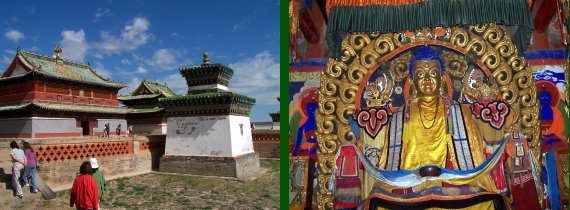
Khar
Khorin is currently excavated jointly by Mongolian and German archaeologists
hoping to re-discover some of its grandeur for increasing number of visitors
to Mongolia. In the meantime, we must rely on descriptions of this capital
from a few contemporary sources. Some of them as, for example, a narrative
of Marco Polo who himself did not make it to Khar Khorin, seem to be rather
exaggerated mentioning the city being surrounded by an earthen wall about
5 km in circumference. In reality, it appears that Khar Khorin was built
on somewhat irregular rectangular plan, 1.5 by 2.5 km, with the town walls
sufficient to control access to the town (four gates) but not prepared
to defend its inhabitants from any major attack.
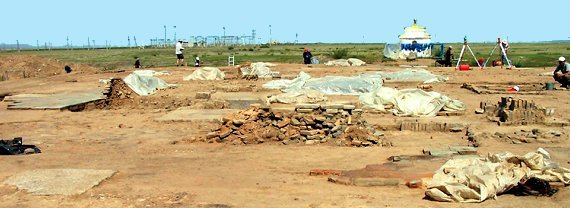
The
most reliable account written by the Franciscan monk, William of Rubruck,
who visited Khar Khorin in the 1250s and stayed there for a year, described
its size as not being “… as large as the village of Saint Denis, and the
monastery of Saint Denis is worth ten times more than the [Khan’s] palace.”
However, at least twice a year when the Khan was passing through his capital
(“once about Easter, when he passes there, and once in summer, when he
goes back [westward]”) the city and its palace were full of life. People
were coming with their gers setting up the true Ger City from as far as
“distant two months journey. ” They were greeted by the Khan who “then
makes them largess of robes and presents, and shows his great glory.

There
are there many buildings as long as barns, in which are stored his provisions
and his treasures.” Everyone was invited for seasonal feasts, which always
involved obscene amount of alcohol. The famous silver fountain was designed
by a captive Parisian goldsmith, Guillaume Bouchier, specifically for the
purpose of drinking: mare’s milk was gushing from silver lion’s heads while
wine and other alcoholic beverages were flowing freely from the mouths
of four golden dragons guarding a sculpted, huge, silver evergreen tree
in the middle. This “monstrosity” was decorated at the top of the tree
with the figure of an archangel blowing a trumpet that, in reality, was
used as a disguise for a servant sending orders to others to start pumping
drinks out of the fountain. Obviously, money cannot buy taste…
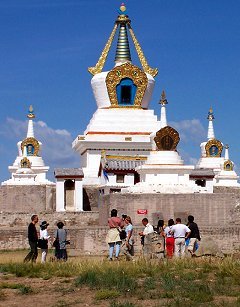 |
 ... ... |
But
almost everything else could have been bought and the best of the best
could have been spotted in Khar Khorin, including quite cosmopolitan of
the crowd. Following William of Rubruck’s description we learn more about
famous Mongolian tolerance for different religions:
There
are two quarters in it (the capital]: one of the Saracens [Muslims] in
which are the markets, and where a great many Tartars [Mongols] gather
on account of the court, which is always near this [city], and on account
of the great number of ambassadors; the other is the quarter of the Cathayans
[Chinese], all of whom are artisans. Besides these quarters there are great
palaces, which are for the secretaries of the court. There are there twelve
idol temples [Buddhists] of different nations, two mahummeries [mosques]
in which is cried the law of Mahomet, and one church of Christians in the
extreme end of the city.” |
Such
the tolerance and recognition of others’ skills never stopped Mongolian
khans from exterminating those who opposed them in any shape or form. Simply
speaking, they never discriminated against the others, whether with life
or with death.
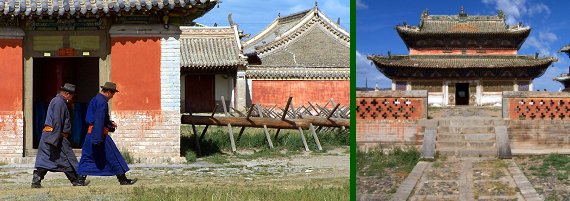
There
is one more mystery associated with Khar Khorin: Was Genghis Khan buried
near it or somewhere else? Most scholars believe that his tomb has been
hidden somewhere in the Khentii province but there are many people who
are continuously looking for this famous grave in many other places, including
Western China (see China). As the
legend says, it was Genghis Khan’s wish to keep location of his tomb in
secrecy. All those who were involved in building it were either killed
or committed suicide to guard its secret. The earth was trampled over the
grave by thousands of horses to make sure that nothing would be seen to
reveal its location. However, as the story goes in the West, there are
at least a few Mongols who know exactly where their Great Khan was put
to rest but out of great respect for him and due to the legendary loyalty
of Mongolian nomads to their leaders, they refuse to disclose the location.
ERDENE
ZUU KHIID
The
ruins of Khar Khorin were put into good use in 1586 when the monastery
of Erdene Zuu (Hundred Treasures) was set up by Abtai Khan. It was the
first Buddhist monastery in Mongolia which then was followed by hundreds
all over its territory. The Third and the Fourth Dalai Lama were reborn
in Mongolia. The Fourth one was a nephew of Altan Khan (himself a descendant
of Genghis Khan) who in 1577 invited the spiritual leader of Tibet, Sodnomjamtso,
to Mongolia. Under his influence Altan Khan adopted the Lamaism,
the so-called yellow faith of Buddhism, and bestowed the title of Dalai
Lama (“Ocean Lama”) on Sodnamjamtso as the leader of the Lamaism. Since
that time, the head of the Buddhist church in Tibet is known as the Dalai
Lama.
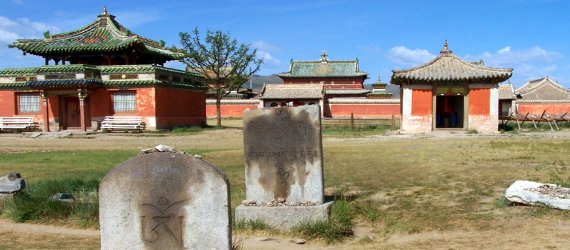
Erdene
Zuu was built for about 300 years and at its height encompassed over 100
temples, with a thousand monks living in gers nearby. Today only a few
of them survived after centuries of tumultuous history of the Mongols.
The temples of Erdene Zuu, built mostly in Tibetan style (see China)
contain an excellent collection of tsam masks, wooden and bronze statues,
appliqués and papier-mâché of various gods made between
the 16th and 18th century.
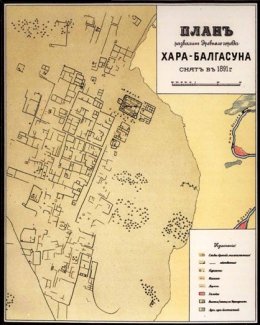 |
 ..... ..... |
KHAR
BALGAS
The
fortress of Khar Balgas, also known in Turkic languages as Kara Balgasun,
is an archaeologist’s dream. Located on the eastern bank of the Orkhon
river, this city was once a capital of the Uighur (one of the Turkic groups)
Khanate which ruled Mongolia between 745-854.

|
Khar
Balgas was founded on a virgin soil in 751 and “went out of use” for different
reasons almost one hundred years later. The layout of this city is clearly
visible even to a non-professional eye: the outer walls with northern and
southern gates; lookout towers; remains of the khagan’s (ruler’s) castle;
a Buddhist stupa; stables; streets; residential and commercial areas; outside
market places, and many other features are well distinguished by different
colors of flora.
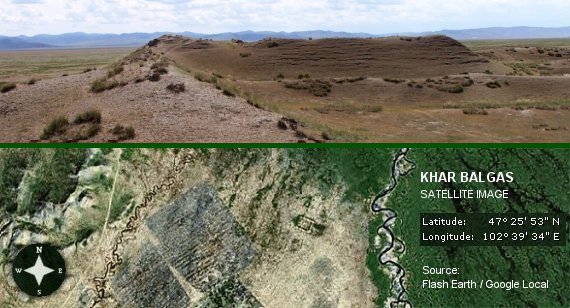
There
is a brief description of Khar Balgas left by an Arab ambassador who visited
the city in 821. After weeks of traveling through vast steppes of Mongolia
he finally arrived at “a great town, rich in agriculture and surrounded
by rustaqs [settlements] full of cultivation and villages lying close together.
The town has twelve iron gates of huge size. The town is populous and thickly
crowded and has markets and various trades.” Another great memory carried
about Khar Balgas is the presence of the Gold Yurt (Mongolian ger), which
was towering over the walls of the city attracting visitors.
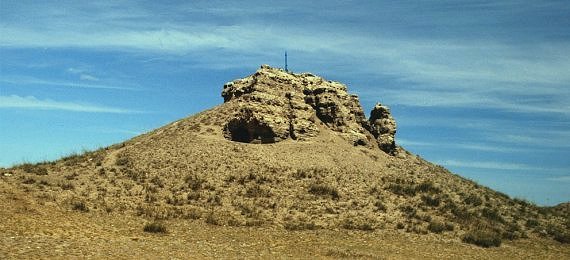
The
Uighurs were one of the largest groups of Turkic peoples who dominated
Central Asian steppes in between 6th and 10th centuries. The term “Uighur”
is usually translated as “united” or “allied” but its original meaning
is still disputed. At the height of their power when Khar Balgas was flourishing,
they were even more powerful than the Chinese emperor who needed them twice
to save his own skin.

Out
of necessity, the Chinese “lowered” themselves to the level of the barbarians
(the Uighurs) by letting them marrying their princesses, not mentioning
the fact that they had to overpay significantly for acquiring horses from
these fearless nomads.
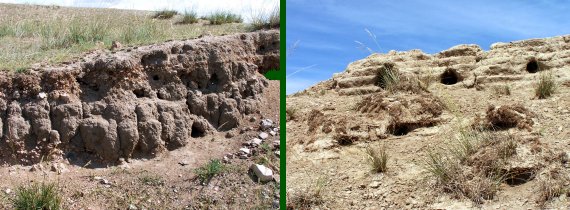
Unfortunately,
life seems to become too easy for the Uighurs (meaning: they almost forgot
about their nomadic origin) who after ca.100 years of ruling over an impressive
empire stretching from the Caspian Sea to Manchuria, were overrun by their
distant cousins, the Kyrgyz (see Kyrgyzstan).
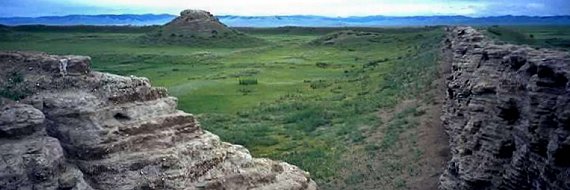
In
the meantime the Uighur tried and/or adopted different religions such as
shamanism, early Buddhism, Manicheism, and eventually Islam. Forced out
of their land in Mongolia they moved back to their former land in modern
Chinese province of Xinjiang (see China
[Urumchi-Turpan]).

TURKIC
MONUMENTS OF THE ORKHON VALLEY
There
is nothing more important to any people that establishing their roots.
The Turkic inscriptions found in Mongolia are the earliest written evidence
in Turkic script (Gokturk runic script; with the Chinese text) about the
powers of the Turkic Khagans (a great empire between the 6th and 8th century),
and the first time when the word “Turk” is mentioned. There are three
of them, all dated to the 8th century.
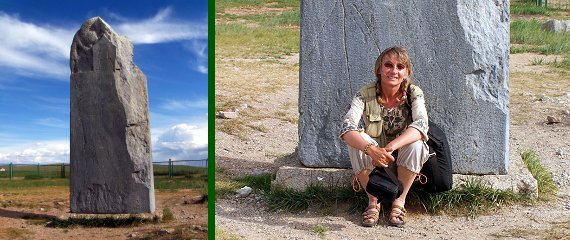
Two
of them, known as monuments of Kul Tegin and of Bilge Khagan, are found
in the Orkhon Valley while the third one, the Tonyukuk monument, is located
360 km away on the Tula River. The Kul Tegin’s stela was erected in his
memory in 732 by his brother, Bilge Khagan. The Bilge Khagan’s monument
was founded in 735 by his son, Tenri Khagan. They are quite impressive
(Kul Tegin’s stela still stands over 3 m) describing both weaknesses and
strengths of the Turkic empire and his rulers. Before Elterish re-united
the Turks again (682-692), his son described the situation of the empire
in the following words:

Weeping
and lamenting came from where the sun rises; the strong people of the desert
came, lamenting and weeping, for these had really been valiant khagans.
After
that their younger brothers became khagans, their sons became khagans.
But the younger brothers were unlike their elder brothers, the sons were
unlike their fathers. Unwise khagans, weak khagans ascended the throne,
and their officers were also unwise and weak.

And
because of the iniquity of the nobility and of the people, because of Chinese
guile, because the elder brothers and the younger brothers were plotting
against each other, because of the quarrel of those who favored the nobles
and those who favored the people, the Turkic people brought about the dissolution
of the empire that had been its empire, and ruined the khagan who had been
its khagan.
The
sons of the nobles became the slaves of the Chinese people, their pure
daughters became its servants. The noble Turks abandoned their Turkic titles
and, assuming Chinese titles, they submitted to the Chinese khagan.
But
the small people, in its entirety, thus said, "We were a people that had
its own empire. Where is now our empire? We were a people that had its
own khagan. Where is now our khagan?
And
thus speaking they became the enemy of the Chinese.

But
then:
My
father [Elterish] the khagan set out with 27 men, and as word got around
that he was advancing, those who were in the towns and those who were in
the mountains gathered, and there were 77 men. Because Heaven gave them
strength, the army of my father resembled wolves and his enemies resembled
sheep. Leading campaigns to the east as to the west, he gathered the people
and made them rise up. And altogether they numbered 700. He lead 47 campaigns
and fought in 20 battles. And because Heaven was favorable towards him,
he deprived of their empire those who had an empire; he deprived them of
their khagan; he pacified his enemies and made them bend their knees and
bow their heads.
Unfortunately,
Elterish’s brother, Qapaghan (692-716), who was able to unify both the
Western Turks and his own Eastern Turks under his leadership was murdered
and decapitated by another Turkic group in 716. The crisis followed and
only by staging a coup Elterish’s son, Kul Tegin, saved the empire. Being
an unselfish brother and following the tradition of seniorship he proclaimed
his elder brother, Bilge, a new khagan (no wonder that Bilge erected a
stela in his honor).
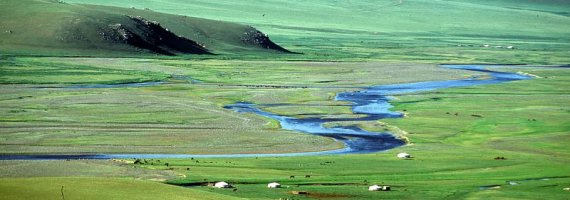
Thus,
Bilge Khagan (716-734) says about himself and his people:
I (Bilge)
did not reign over a people that was rich, I reigned over a people weak
and frightened, a people that had no food in their bellies and no clothes
on their backs. To preserve the reputation achieved by our father, for
the sake of the Turk people, I spent the nights without sleep and the days
without rest. When I became khagan, the people who had dispersed to different
countries returned, at the point of death, on foot and naked. To reestablish
the nation, I led twenty-two campaigns. And because of good fortune and
propitious circumstances, I brought back to life the dying people, the
naked people I clothed and the few I made numerous.
This
just ruler was poisoned by one of his officials but before he died he had
found time to execute him and his family. Unfortunately, this Turkic empire
died with him but the new one (the Uighurs) was waiting to emerge (see
above).

(back
to the top)
| .. |
|
 |
NOTES:
Most of the pictures are taken and copyrighted by Ewa Wasilewska, a few
have been borrowed for educational purposes from different Internet sites. |
| .. |
|

|
Basic
information about Mongolia |
|

